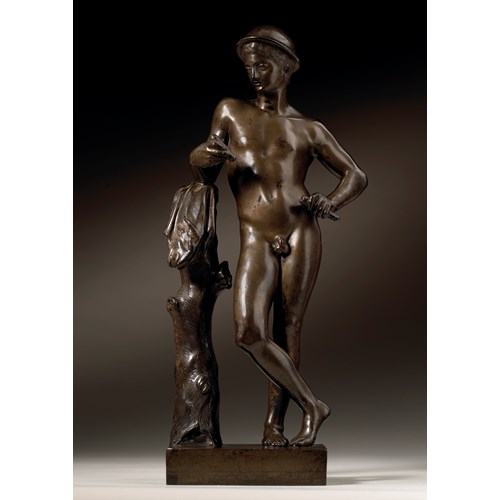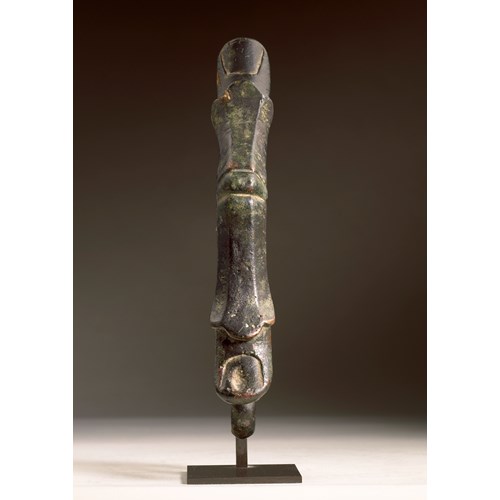Marketplace
Important pair of large carved Egyptian Porphyry vases and covers
Important pair of large carved Egyptian Porphyry vases and covers
Date mid-18th century
Epoque 1750-1850, 18th century
Origine Italy
Medium Porphyry
Dimension 100 cm (40 inches)
In exceptional state of conservation, this magnificent pair of Egyptian imperial porphyry vases are 18th century Roman pietra dura objets d’art of the highest quality. Their surface shimmers and captures the beholder thanks to its vivid deep red hue, interspersed with luminous specks of white, a unique colour that had so fascinated the emperors of Antiquity. Wonderfully refined in design, these vessels are closely related to a single specimen, sold by Tomasso Brothers in 2006 and formerly in the renowned Wildenstein collection, of comparably elongated shape and decorated with satyr mask handles. The same motif, surely a homage to the ancient roots of the stone, appears in a pair of beautiful porphyry vases formerly in the collection of Hubert de Givenchy, sold at Christie’s in 1993.
Such pietra dura vases were inspired by 17th century prototypes as illustrated, for example, in Stefano della Bella’s Raccolta di Vasi Diversi (1664). This tradition was continued the following century by renowned artists such as Giovanni Battista Piranesi (Vasi candelabri cippi sarcofagi tripodi lvcerne ed ornamenti antichi, 1778) and Joseph-Marie Vien, whose designs were published in 1760 under the title Suite de Vases dans le Goût de l'Antique. Remarkably, plate 13 in the latter features a vase with satyr mask handles closely comparable to the present ones.
Avidly collected by the Italian nobility, with the onset of the Grand Tour tradition in the mid-18th century porphyry gradually appeared in the grandest houses across Europe. The Duc d’ Aumont (1709 – 1782), a noted collector, is credited with introducing the taste for hardstone objects, including vases, to Paris, and notably established the Hôtel des Menus-Plaisirs lapidary workshop at Versailles in the second half of the 18th century. On the other side of the channel, in 1714 Lord Burlington came back from his Grand Tour with two monumental porphyry urns, which he installed in his celebrated neo-Palladian villa at Chiswick, whilst in the early 1770s the Duchess of Beaufort had a statuary marble and porphyry chimneypiece fitted at Badminton Hall, Gloucestershire, decorated with a relief after the Borghese Dancers. Thirty years later Gregorio Franchi, the companion and agent of famed (and defamed) art collector and novelist William Beckford, was recorded as acquiring porphyry in Rome, which autograph letters prove was then incorporated in two exquisite side cabinets made for Beckford following designs by Franchi himself.
Porphyry, or Lapis Porphyrites, was quarried by ancient Romans at Mons Porphyrites, part of the modern Gebel Dokhan in Egypt, following its discovery in the age of Emperor Tiberius (14-37 AD). Due to the exceptional quality of its surface and its rarity porphyry was employed only for the grandest and most important commissions, from temples such as the Pantheon to monuments such as the portrayal of the Four Tetrarchs, now in Venice, and the sarcophagi of Emperor Constantine’s family. Excavations at Mons Porphyrites had ceased by the early 5th century AD and, whilst porphyry continued to be the prerogative of rulers throughout late antiquity – in 786 Charlemagne was granted permission by Pope Hadrian I to take porphyry columns from Rome for his cathedral in Aachen – the stone’s true rediscovery took place in Renaissance Italy. Following in Charlemagne’s footsteps, sculptors and architects thus reused and cut their works from ancient Roman columns, or the occasional slab found intact since imperial times. This practice continued into the following centuries, as the Egyptian quarry lay dormant until its identification at the beginning of the 19th century.
Such pietra dura vases were inspired by 17th century prototypes as illustrated, for example, in Stefano della Bella’s Raccolta di Vasi Diversi (1664). This tradition was continued the following century by renowned artists such as Giovanni Battista Piranesi (Vasi candelabri cippi sarcofagi tripodi lvcerne ed ornamenti antichi, 1778) and Joseph-Marie Vien, whose designs were published in 1760 under the title Suite de Vases dans le Goût de l'Antique. Remarkably, plate 13 in the latter features a vase with satyr mask handles closely comparable to the present ones.
Avidly collected by the Italian nobility, with the onset of the Grand Tour tradition in the mid-18th century porphyry gradually appeared in the grandest houses across Europe. The Duc d’ Aumont (1709 – 1782), a noted collector, is credited with introducing the taste for hardstone objects, including vases, to Paris, and notably established the Hôtel des Menus-Plaisirs lapidary workshop at Versailles in the second half of the 18th century. On the other side of the channel, in 1714 Lord Burlington came back from his Grand Tour with two monumental porphyry urns, which he installed in his celebrated neo-Palladian villa at Chiswick, whilst in the early 1770s the Duchess of Beaufort had a statuary marble and porphyry chimneypiece fitted at Badminton Hall, Gloucestershire, decorated with a relief after the Borghese Dancers. Thirty years later Gregorio Franchi, the companion and agent of famed (and defamed) art collector and novelist William Beckford, was recorded as acquiring porphyry in Rome, which autograph letters prove was then incorporated in two exquisite side cabinets made for Beckford following designs by Franchi himself.
Porphyry, or Lapis Porphyrites, was quarried by ancient Romans at Mons Porphyrites, part of the modern Gebel Dokhan in Egypt, following its discovery in the age of Emperor Tiberius (14-37 AD). Due to the exceptional quality of its surface and its rarity porphyry was employed only for the grandest and most important commissions, from temples such as the Pantheon to monuments such as the portrayal of the Four Tetrarchs, now in Venice, and the sarcophagi of Emperor Constantine’s family. Excavations at Mons Porphyrites had ceased by the early 5th century AD and, whilst porphyry continued to be the prerogative of rulers throughout late antiquity – in 786 Charlemagne was granted permission by Pope Hadrian I to take porphyry columns from Rome for his cathedral in Aachen – the stone’s true rediscovery took place in Renaissance Italy. Following in Charlemagne’s footsteps, sculptors and architects thus reused and cut their works from ancient Roman columns, or the occasional slab found intact since imperial times. This practice continued into the following centuries, as the Egyptian quarry lay dormant until its identification at the beginning of the 19th century.
Date: mid-18th century
Epoque: 1750-1850, 18th century
Origine: Italy
Medium: Porphyry
Dimension: 100 cm (40 inches)
Provenance: Villa Mylius, Genoa, since at least the late 19th century
Private collection, United Kingdom
Literature: D. del Bufalo, Porphyry, Red Imperial Porphyry, Power and Religion, Turin, 2012, no. V128
Plus d'œuvres d'art de la Galerie









